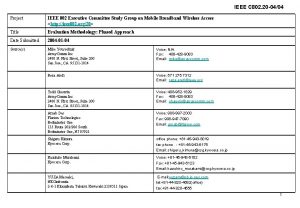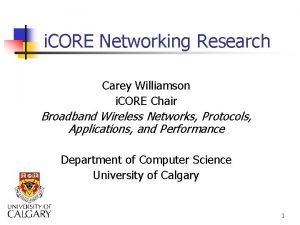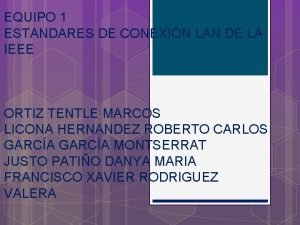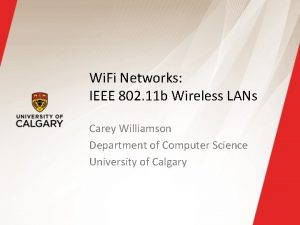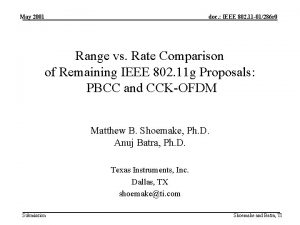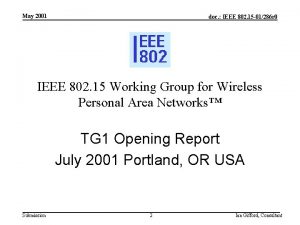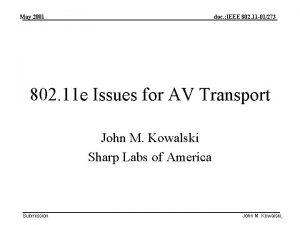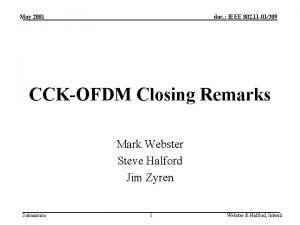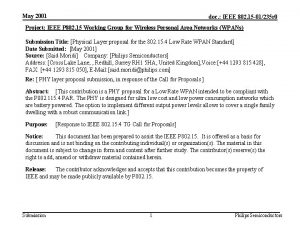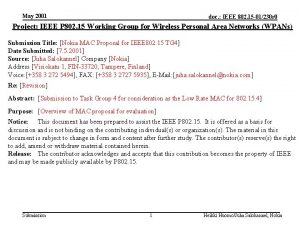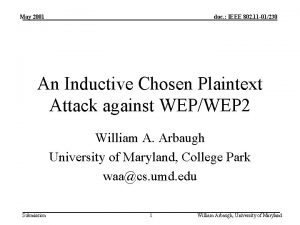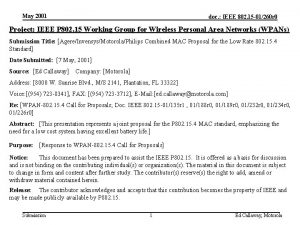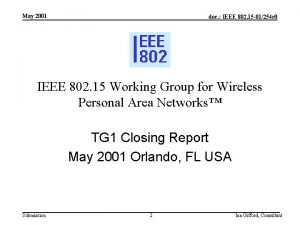May 2001 doc IEEE 802 11 01286 r
















- Slides: 16

May 2001 doc. : IEEE 802. 11 -01/286 r 1 Range vs. Rate Comparison of Remaining IEEE 802. 11 g Proposals: PBCC and CCK-OFDM Bill Carney Matthew B. Shoemake, Ph. D. Anuj Batra, Ph. D. Texas Instruments, Inc. Submission Carney, Shoemake, and Batra, TI

May 2001 doc. : IEEE 802. 11 -01/286 r 1 PBCC-22 (+. 11 a): Backwards AND Forward Compatibility gaional 54 pt O Data Rate Mbps gbdatory n Ma 22 11 OFDM 2. 4 GHz PBCC-22 802. 11 g Mandatory 802. 11 b CCK/PBCC 1999 Submission 802. 11 a Note: PBCC will be in the 2. 4 GHz band 2001 2003 Carney, Shoemake, and Batra, TI

May 2001 doc. : IEEE 802. 11 -01/286 r 1 PBCC-22 (+. 11 a) • No barriers for all market participants – Royalty Free IP licenses – Texas Instruments offers PBCC cores – True 802. 11 a OFDM system in 2. 4 GHz • PBCC-22 mandatory implementation the technically superior solution for high rate, full backwards compatibility Submission Carney, Shoemake, and Batra, TI

May 2001 doc. : IEEE 802. 11 -01/286 r 1 Range vs. Rate Performance Submission Carney, Shoemake, and Batra, TI

May 2001 doc. : IEEE 802. 11 -01/286 r 1 Approach • Use PER vs. SNR curves for PBCC and CCK-OFDM in conjunction with standard IEEE 802. 15. 2 path loss models as well as power amplifier back off and maximum sustainable throughput values from authors of PBCC and CCK-OFDM Submission Carney, Shoemake, and Batra, TI

May 2001 doc. : IEEE 802. 11 -01/286 r 1 Calculation of Receiver Power • The received power is taken as a simple function of the actual Effective Isotropic Radiated Power (EIRP), the path loss using the IEEE 802. 15. 2 indoor model, and the PA backoff: PRX = PMAX, TX – PPathloss – PPA Backoff • Assume PMAX = 100 m. W Submission Carney, Shoemake, and Batra, TI

May 2001 doc. : IEEE 802. 11 -01/286 r 1 IEEE 802. 15. 2 Path Loss Model • Assumes line of sight for less than 8 m: Lpath = 10 log (4 p r 2 / l) d. B, r < 8 m • After 8 m, assumes indoor path loss exponent of 3. 3: Lpath = – 37. 7 + 10 log(4 p r 3. 3 / l) d. B, r > 8 m • Where: l = wavelength @ 2. 45 GHz (0. 1224 m) r = range (m) • Reference: 802. 15 doc. 00/134 Submission Carney, Shoemake, and Batra, TI

May 2001 doc. : IEEE 802. 11 -01/286 r 1 Power Amplifier Back-off • The PA Backoff for the remaining proposals are: PA Back. Off. CCK-OFDM = 6 d. B PA Back. Off. BARKER/CCK/PBCC = 4 d. B • Using the same radio, CCK-OFDM requires 2 d. B more back off than Barker/CCK/PBCC systems. • Note that CCK-OFDM has lower average power than Barker/CCK/PBCC. Submission Carney, Shoemake, and Batra, TI

May 2001 doc. : IEEE 802. 11 -01/286 r 1 Calculation of Noise at Receiver • The noise is taken as a function of thermal noise received through an ideal matched filter for each modulation and a noise figure: N = Nthermal + NNoise. Figure • Assume NNoise. Figure = 6 d. B Submission Carney, Shoemake, and Batra, TI

May 2001 doc. : IEEE 802. 11 -01/286 r 1 Thermal Noise Floor and Spectral Masks • The thermal noise floor is: – 114 d. Bm/MHz • An ideal matched filter will capture a noise power of: – OFDM: – 95. 9 d. Bm – PBCC: – 103. 6 d. Bm • A CCK-OFDM matched filter will capture 7. 7 d. B more noise than a Barker/CCK/PBCC matched filter! Submission Carney, Shoemake, and Batra, TI

May 2001 doc. : IEEE 802. 11 -01/286 r 1 Calculation of Received SNR • The received SNR is then simply calculated as the ratio of the received power to the noise with the addition of a multipath loss factor SNR = PRX / N – Loss where Loss = Implementation Loss + Multipath Margin • Assume Loss = 10 d. B Submission Carney, Shoemake, and Batra, TI

May 2001 doc. : IEEE 802. 11 -01/286 r 1 Calculation of Throughput • Maximum Sustainable Throughputs (MST) from doc. 01/059 by Halford, Webster and Zyren are used. – – Assumed data length = 1000 B IEEE 802. 11 b short preamble With ACK packets No backoff (only DIFS included; similar to 802. 11 e HCF) • The throughput TPER is calculated as the MST divided by the average number of attempts to successfully send a packet. (Note that this is a function of the PER. ) Submission Carney, Shoemake, and Batra, TI

May 2001 doc. : IEEE 802. 11 -01/286 r 1 PER vs. SNR for IEEE 802. 11 b + PBCC 22 Plot relates the Packet Error Rate (PER) for each modulation to the ratio of the signal strength at the receiver to the noise strength at the receiver. Submission Carney, Shoemake, and Batra, TI

May 2001 doc. : IEEE 802. 11 -01/286 r 1 PER vs. SNR for CCK-OFDM Submission Carney, Shoemake, and Batra, TI

May 2001 doc. : IEEE 802. 11 -01/286 r 1 Range vs. Rate Performance Submission Carney, Shoemake, and Batra, TI

May 2001 doc. : IEEE 802. 11 -01/286 r 1 Conclusion • PBCC-22 has larger range and coverage area than either CCK or CCK-OFDM. • 802. 11 a has higher Maximum Sustainable Throughputs than CCK-OFDM with the same range. Submission Carney, Shoemake, and Batra, TI












